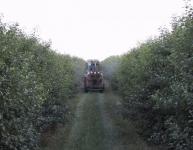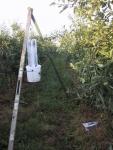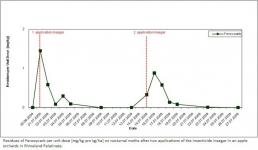The project was conducted by the Institute for Environmental Sciences from the University Koblenz-Landau between May and December 2009, funded by German Federal Ministry for the Environment, Nature Conservation and Nuclear Safety.
Risk assessment procedures for the registration of pesticides within the EU also consider birds and mammals (SANCO/4145/2000). The relevant guideline was just revised in 2009 (EFSA 2009) but does not make reference to bats because only a few studies investigated their presence in the agricultural landscape.
In this project bat activity was monitored in a conventionally cultivated apple orchard at ten time points after two insecticide applications (Insegar) using batcorder detection systems (ecoObs GmbH). To place the obtained bat activity in relation, we also recorded along two forest roads of the nearest deciduous forest (approx. 1.5 km away), a habitat known to present a preferable foraging area for bats. In parallel we sampled different nocturnal insect groups to describe the residue pattern of Insegar on the foot items of several foraging guilds, namely open space foragers hunting big insects (e.g. Eptesicus serotinus), open space foragers hunting small insects (e.g. Pipistrellus pipistrellus), gleaners (e.g. Plecotus auritus) and foragers specialized in the predation of ground-dwelling carabids (Myotis myotis). Insegar residues in the insect samples were detected by the use of liquid chromatography-mass spectrometry.
The common pipistrelle (Pipistrellus pipistrellus) was by far the most frequently detected bat species but also the serotine (Eptesicus serotinus), Leisler`s bat (Nyctalus leisleri), the whiskered bat (Myotis mystacinus), the grey long-eared bat (Plecotus austriacus), a rare and highly endangered species in the area, the noctule (Nyctalus noctula) and the Great mouseeared bat (Myotis myotis) have been recorded in the orchard (in decreasing order). It has been found that an area of the orchard had a comparable and even slightly higher bat foraging activity than recorded in the forest roads. Foot items of gleaner and open space foragers hunting small insects (e.g. Pipistrellus pipistrellus) showed the highest residues in the present study.
In summary, the present study shows that foraging activity of bats is occurring in intensively managed orchards even at times when pesticides are applied. Their insect food items reveal as a result pesticide residues (detailed results in prep).
The lipophilic insecticide Insegar (Fenoxycarb), a potential endocrine compound, is currently applied up to three times during the lactation period of bats from May to July. Lipophilic pesticides are considered to have a detrimental effect on bats by accumulating in the bat`s stored fat due to the consumption of pesticide laden insects. When the fat is metabolized during hibernation or migration, the pesticide concentrations can potentially reach high levels, especially in the brain. Additionally, lactating females could transfer the lipophilic compound through milk to the offspring. To estimate the risk of a certain species toxicity measurements based on acute oral exposure in tests are necessary. As for mammals toxicity endpoints (LD50) are available only for the rat (Rattus norvegicus), shrew (Sorex araneus), vole (Microtus arvalis), wood mouse (Apodemus sylvaticus) and the rabbit (Oryctolagus cuniculus) but are lacking for any European bat species. By being 100% insectivores, requiring an enormous amount of food compared to their body weight due to their high metabolic rate, and by physiological constraints due to hibernation bats differ in many aspects from each of the listed mammals. Thus, we conclude that bats are potentially more sensitive to pesticides than other mammals and that the current risk assessment for mammals might therefore underestimate the risk towards bats. Therefore we strongly suggest the consideration of bats in the risk assessment scheme for pesticides and a thorough research program that is investigating the effect of pesticides on bats.


